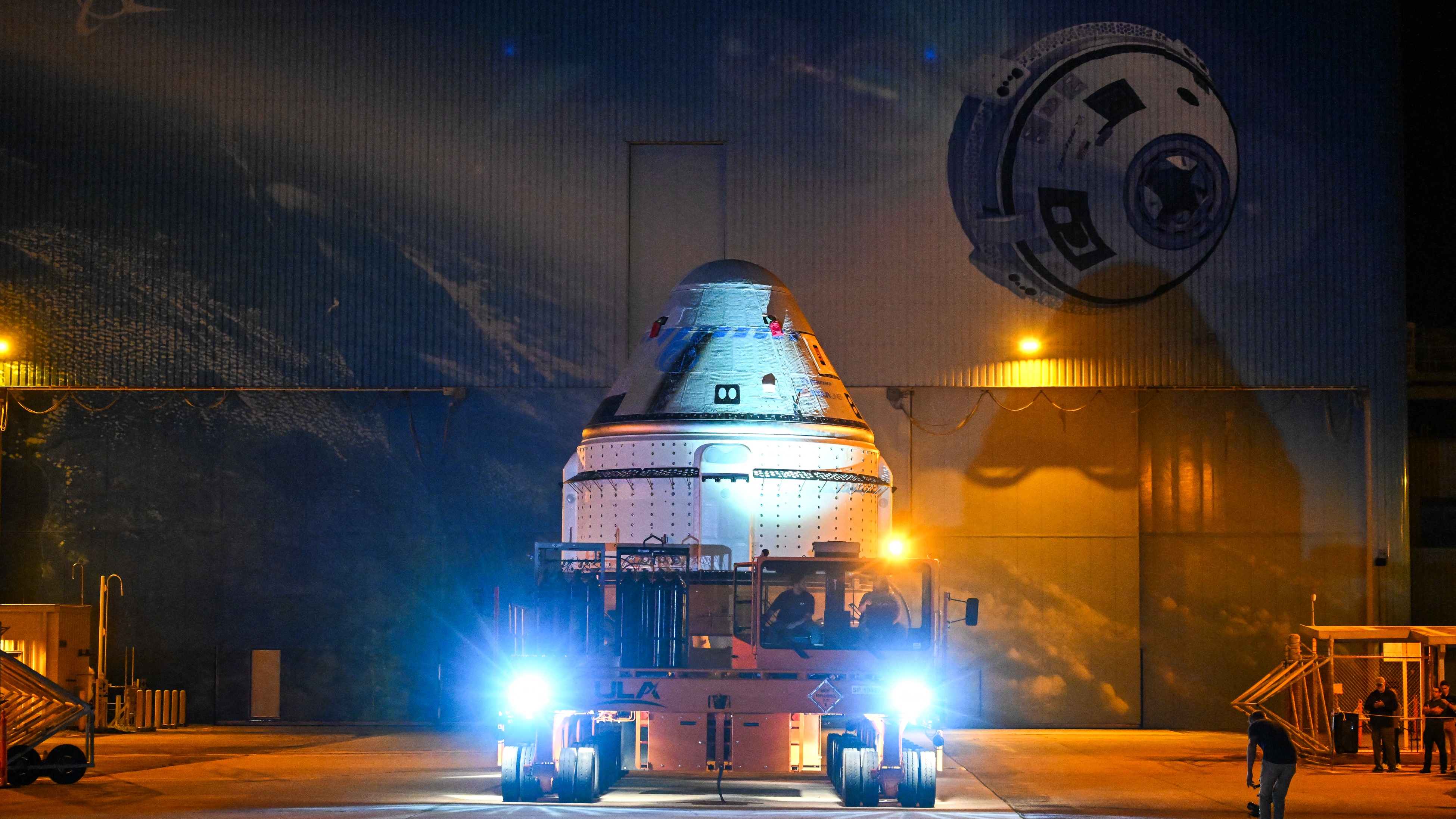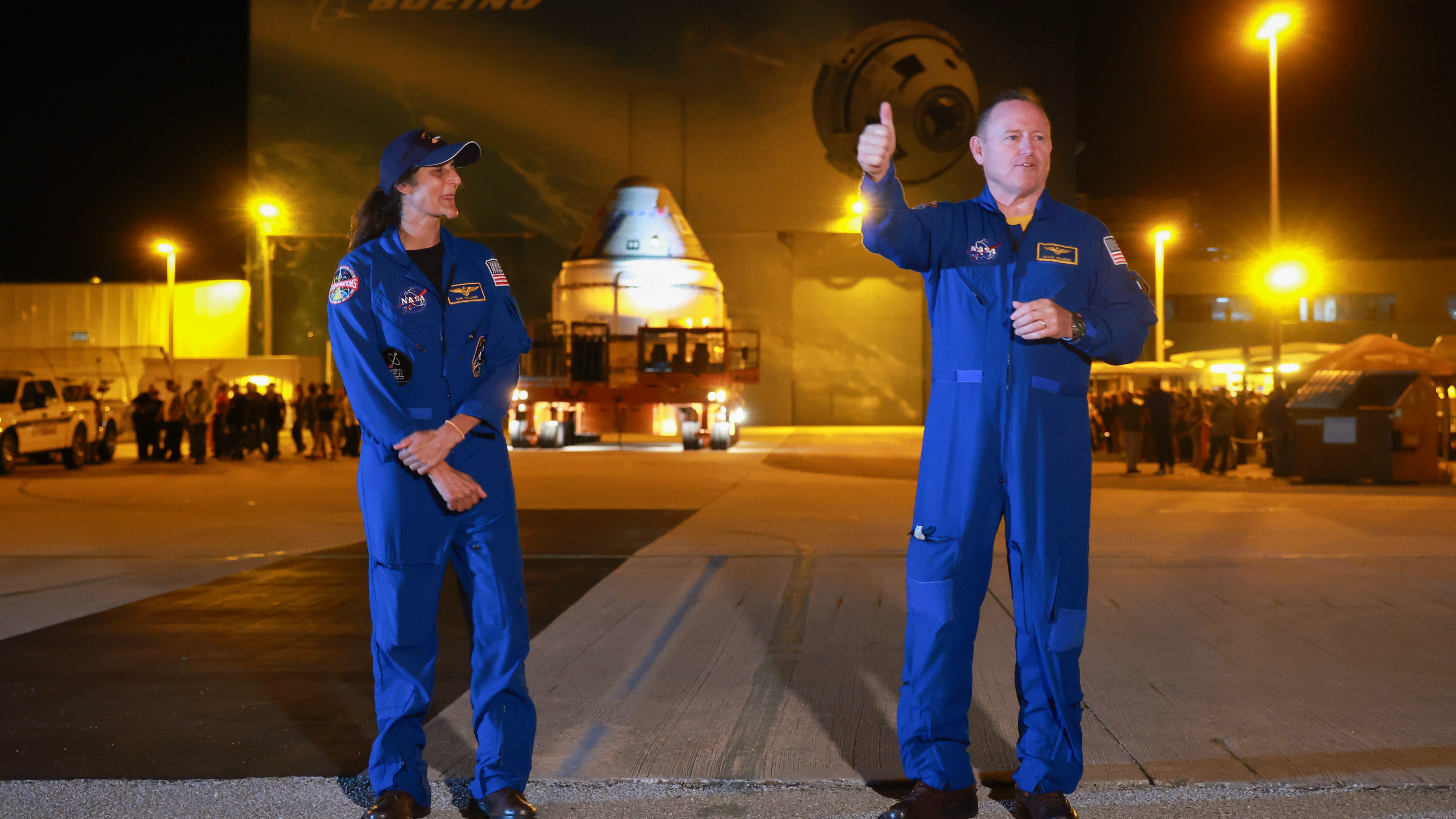Boeing Starliner spacecraft rolls out to Atlas V rocket ahead of 1st astronaut launch (photos, video)
Boeing's first Starliner spacecraft for astronauts made a short road trip today (April 16) ahead of its expected launch in early May.
Starliner rolled out on a trailer towards its United Launch Alliance (ULA) Atlas V rocket around 5 a.m. EDT (0900 GMT) in preparation for its International Space Station (ISS) mission no earlier than May 6. Onboard the mission, known as Crew Flight Test (CFT), will be two veteran NASA astronauts and former Navy test pilots: commander Barry "Butch" Wilmore and pilot Suni Williams.
Early this morning, Boeing rolled out of the commercial crew and cargo processing facility at NASA's Kennedy Space Center (KSC) near Orlando, Florida to begin a 6-mile (10-kilometer) journey towards its Atlas V rocket in a separate building. Several astronauts were on hand to witness the historic journey.
Starliner's destination was ULA's vertical integration facility, also at KSC, where the Atlas V rocket is accomplocated. Boeing Space announced on X, formerly Twitter, that rocket and spacecraft were successfully integrated in a post at 11:46 a.m. EDT (1546 GMT).
"Functionally, this rollout was similar in nature to previous rollouts," Amanda Ireland, Boeing's spacecraft liaison, said in a company statement, including "treating the spacecraft with the greatest care and detail."
Once stacking is complete and communications verified between rocket and spacecraft, the vehicles will be rolled out together to the launch pad at KSC.
Breaking space news, the latest updates on rocket launches, skywatching events and more!
The upcoming roughly week-long CFT mission Starliner will run to the ISS aims to test out all major systems with astronauts on board. CFT follows two uncrewed flights by Starliner: A 2019 flight that did not reach the ISS as planned, and a 2022 attempt (following numerous changes to Starliner) that reached the ISS and met all other major flight objectives.
Crews for both CFT and the first operational six-month ISS mission in 2025 were on hand to watch the Starliner rollout.
Astronauts for that first operational mission, known as Starliner-1, include NASA's Scott Tingle, NASA's Mike Fincke and the Canadian Space Agency's Joshua Kutryk. Also present at the rollout was Kimiya Yui, an astronaut from the Japan Aerospace Exploration Agency or JAXA, who is unassigned for a spaceflight so far.
Astronauts Butch Wilmore, @Astro_Suni, @AstroIronMike, @Astro_Kutryk, @Astro_Maker1 and @Astro_Kimiya are here to see the #Starliner spacecraft off. pic.twitter.com/PHaZsLoIb7April 16, 2024
CFT has been delayed by several years in sending crews to the ISS due to numerous technical problems, including more uncovered in 2023. The suspension lines of Starliner's main parachutes could handle less load than engineers thought, and the capsule's wiring was largely made up of flammable P213 tape.
Boeing and NASA, alongside Starliner astronauts, emphasize that past issues are behind them and that Starliner is ready to bear crews. CFT will be a major checkout of all systems to certify Starliner for longer missions, six months or more, for standard ISS crew changeouts.
Boeing and SpaceX received contracts from NASA in 2014 for commercial crew missions to the ISS. Boeing's contract for the Starliner is valued at $4.2 billion, compared to SpaceX's $2.6 billion.
SpaceX began operational astronaut missions with Crew Dragon in 2020 and has so far brought 11 crews to ISS: Eight led by NASA and three on behalf of Axiom Space, a Houston company that runs approximately two-week ISS science excursions with a retired NASA astronaut at the helm.
Between the space shuttle's retirement in 2011 and the first operational commercial crew flights of SpaceX's Dragon capsule, NASA flew all astronauts to the ISS aboard Russia's Soyuz spacecraft. The agency continues to send some astronauts on Soyuz for technical and policy reasons.

Elizabeth Howell (she/her), Ph.D., was a staff writer in the spaceflight channel between 2022 and 2024 specializing in Canadian space news. She was contributing writer for Space.com for 10 years from 2012 to 2024. Elizabeth's reporting includes multiple exclusives with the White House, leading world coverage about a lost-and-found space tomato on the International Space Station, witnessing five human spaceflight launches on two continents, flying parabolic, working inside a spacesuit, and participating in a simulated Mars mission. Her latest book, "Why Am I Taller?" (ECW Press, 2022) is co-written with astronaut Dave Williams.




